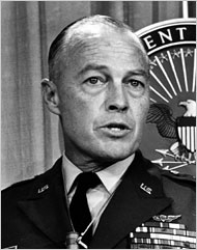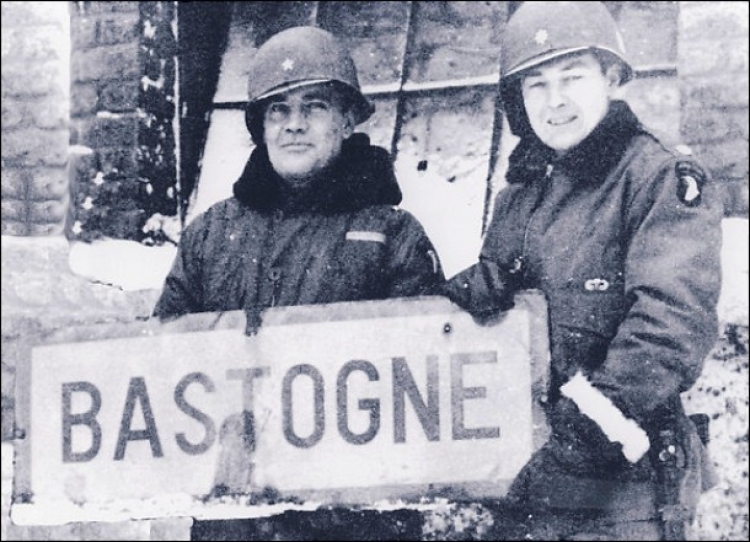
 |
|
|
||
|
Harry William Osborne Kinnard II |
||||
|
Graduate, U.S. Military Academy, Class of 1939 Engagements: • World War II (1941 - 1945)• Korean War (1950 - 1953)• Vietnam War (1960 - 1973) |
||||
| Biography: | ||||
|
Harry William Osborne Kinnard II Harry William Osborne Kinnard II was born on 7 May 1915 in Dallas, TX. Military Service After graduating from the U.S. Military Academy in 1939, he entered military service. On 7 December 1941, Kinnard was stationed at Pearl Harbor, and manned a machine gun to defend the base on the morning of the Japanese attack. Kinnard parachuted into France in the early hours of the Normandy Landings in June 1944, and was awarded the Distinguished Service Cross for his heroism during Operation Market Garden, as part of the Allied airborne attack against German forces in the Netherlands in September 1944. Nuts! In December 1944, during the Battle of the Bulge, German forces surrounded the town of Bastogne, a town in Belgium then held by the 101st Airborne Division and located at a crossroads that could have allowed the Germans to break through the American lines and reach their goal of retaking the port city of Antwerp. With the American forces surrounded, short on supplies, and suffering the effects of the bitter cold weather, two German officers approached the American lines with a demand that the U.S. forces surrender or face destruction. Brigadier General Anthony McAuliffe was serving as Acting Division Commander and was handed the German demand. Kinnard, then a Lieutenant Colonel serving as the Division's Operations Officer, recounted that McAuliffe laughed and said "Us surrender? Aw, nuts." After considering the German demand, McAuliffe said he didn't know what to say in response, to which Kinnard replied, "That first remark of yours would be hard to beat." As recounted by The New York Times in his 2009 obituary, "McAuliffe said, 'What do you mean?' I answered, 'Sir, you said, 'Nuts.' All members of the staff enthusiastically agreed. McAuliffe then wrote down: 'To the German Commander, Nuts! The American Commander.'" McAuliffe's response was passed on to the two German officers who didn't understand its meaning. Colonel Joseph Harper, who had delivered the message, explained to the Germans, "If you don't know what 'nuts' means, in plain English it is the same as 'go to hell.'" Brigadier General McAuliffe asked Kinnard to compose a message that he delivered to the troops in Bastogne on Christmas Day, 1944. The message has been variously recorded as: "What's merry about all this, you ask? Just this: We have stopped cold everything that has been thrown at us from the North, East, South and West. We have identifications from four German Panzer divisions and one German parachute division. The Germans surround us, their radios blare our doom. Their commander demanded our surrender, and received the following reply... 'NUTS!' We are giving our country and our loved ones at home a worthy Christmas present, and, being privileged to take part in this gallant feat of arms, are truly making for ourselves a Merry Christmas." With improving weather allowing air support to assist the troops, the American forces were able to hold Bastogne, with "Nuts" coming to symbolize the American determination to overcome against the odds. Twenty years after the Battle of the Bulge, Kinnard drew criticism from members of the 101st Airborne Division for his comments in a newspaper interview where he said "We never felt we would be overrun. We were beating back everything they threw at us. We had the houses, and we were warm. They were outside the town, in the snow and cold." Many members of E company sent Stephen Ambrose the article containing the comments with their own opinion, the mildest comment by a member of E Company was "What battle was he in?" Airmobile Building on his paratroop service, Kinnard helped develop the airmobile concept, by which troops would be flown into battle by helicopter. He was able to develop this approach while commanding the 11th Air Assault Division (Test) at Fort Benning in 1963. This unit evolved into the First Cavalry Division (Airmobile). Kinnard commanded an operation in October 1965, in which 5,000 troops took control of the Suai Ca Valley, which placed the crop-rich valley under South Vietnamese control. Associated Press reporter Bob Poos described the innovative use of the "Sky Cavalry," combining light infantry on armed helicopters, as constituting 'an exercise in sustained terror." Kinnard was in command in November 1965 during the Unit's first major operation in the Pleiku Campaign. During this action, the Division conducted 35 days of continuous airmobile operations. The opening battle, the Battle of Ia Drang, which resulted in heavy North Vietnamese casualties at the cost of 300 American deaths, was described in the book We Were Soldiers Once… And Young, which was also the basis of the subsequent Mel Gibson film We Were Soldiers. The unit also earned the first Presidential Unit Citation (US) presented to a division during the Vietnam War. Kinnard retired from the Army in 1969. Medals, Awards and Badges Distinguished Service Cross Distinguished Service Cross Citation (Synopsis) The President of the United States takes pleasure in presenting the Distinguished Service Cross to Harry W. O. Kinnard, Jr. (0-5053), Lieutenant Colonel, U.S. Army, for extraordinary heroism in connection with military operations against an armed enemy while serving as Commanding Officer, 1st Battalion, 501st Parachute Infantry Regiment, 101st Airborne Division, in action against enemy forces in September 1944. Lieutenant Colonel Kinnard's intrepid actions, personal bravery and zealous devotion to duty exemplify the highest traditions of the military forces of the United States and reflect great credit upon himself, the 101st Airborne Division, and the United States Army. Headquarters, XVIII Airborne Corps, General Orders No. 36 (1945) Foreign Medals and Awards Officer of the Order of the Crown w/ Palm (Belgium) On 14 November 1946 by Royal Decree, Kinnard was knighted by Queen Wilhelmina, with the rank of Knight 4th class of the Military William Order. The Order is the highest and oldest honor of the Kingdom of the Netherlands, which is bestowed for "performing excellent acts of Bravery, Leadership and Loyalty in battle." It is an extremely prestigious award, comparable to the French Légion d'honneur but far less frequently awarded. Honors In 1974, Kinnard became one of the first inductees into the Army Aviation Hall of Fame. Death and Burial Lieutenant General Harry William Osborne Kinnard II died of Parkinson's disease on 5 January 2009 in Arlington, VA. He is buried at Arlington National Cemetery in Arlington. He was survived by his wife, Libby; two sons, three daughters, a stepson, 2 stepdaughters, 16 grandchildren and 15 great-grandchildren. |
||||
| Honoree ID: 2713 | Created by: MHOH | |||
Ribbons
Medals
Badges
Honoree Photos
 |  |  |
 |  |
 |


